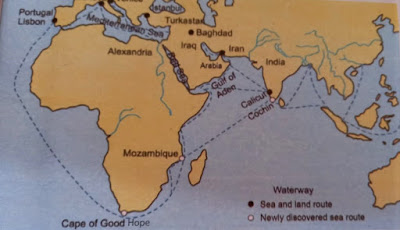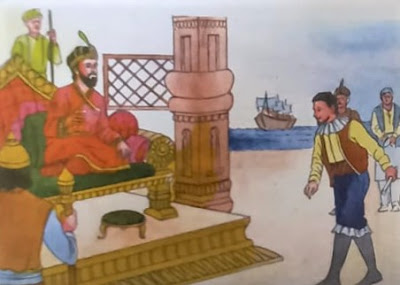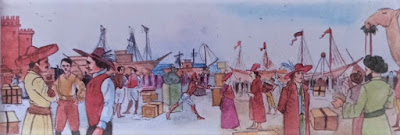Earlier, the merchants from the various countries came to India from north-west by land route for the purpose of trading. For years, the Arab traders undertook trade through land route; but as situations changed, trade through land route stopped. Consequently, the demand for Indian commodities like silk, cotton clothes, muslin, black pepper, spices, etc. increased in the European countries. To take the advantage of this situation, many countries of Europe started searching for a sea route to India.
Christopher Columbus
- Who was Christopher Columbus?
Columbus, an Italian explorer, was one of the brave sailors who ventured out to find the sea route to India. He thought that one can go to the East via West also. Columbus started his journey to India and accidentally reached America. As long as he lived, he was under the misconception that he had discovered the sea route to India. Hence, even today the natives of America are called Red Indians and the island group in the Caribbean is known as the West Indies.
Vasco-Da-Gama
Vasco-Da-Gama, a native of Portugal, discovered the sea route to India. He encircled the 'Cape of Good Hope' in South Africa and reached the Port of Calicut on 22nd May 1498 after crossing the Indian Ocean. Then ruling king of Calicut Zamorin, gave permission to the Portuguese to trade.
The Portuguese established a fort in Calicut for trade in 1500 C.E. They fortified it and appointed a commander in chief, namely Albuquerque, to safeguard the fort. Moving northwards, Albuquerque conquered Goa in 1506 C.E. With a span of 100 years, the Portuguese took control of Mangalore, Cochin, Goa, Diu, Mumbai and Island of Lanka.
End of Portuguese rule
- How did the Portuguese rule come to an end?
In the beginning of the 17th century, the Portuguese expanded their trade to Bengal. At this time, the Mughal Emperor, Shahjahan ruled India from Delhi. The Subedar of Bengal complained to Shahjahan about the behaviour of the Portuguese. Thus, the fort of Hugli was demolished and the ships were burnt as per the order of the Emperor. In this way, the Portuguese rule came to end with exception of the territories of Diu, Daman and Goa.
The Dutch
After 100 years of the arrival of the Portuguese, at the end of the 16th century, the Dutch of Holland (now the Netherlands) came to India for trading. Initially, they established forts at Pulicat and Madras (now Chennai). They also established in India. The Dutch could not withstand the competition against the British.
British Interest in India
During the reign of Queen Elizabeth of England in the year 1600 C.E., the British established the East India Company. This company belonged to merchants who wanted to increase their wealth by undertaking trade with India.
The first British ship arrived in India at the port of Surat in the year 1608 C.E. Captain W. Hawkins, the captain of the ship, was the first British to set foot in India. He met Jahangir but did not get his permission to establish a trading centre in Surat. Later, Delhi went in to the hands of Shahjahan. Shahjahan gave permission to the British to carry out trade in Bengal.
The French
The French established 'The French East India Company' in the year 1664 C.E. They established factories in Surat, Machhalipatnam and Puducherry (Pondicherry). The head of the French company was Joseph Francois Dupleix, who had the desire to expand the European rule in India. Thus, the French and the British stood in competition against each other to become the strongest European company. There were innumerable disputes and battles and finally the British emerged as the winners.; However, the French retained their control over the trading centers of Puducherry, Mahe and Chandranagar.
British Trade in Bengal
The British first started their trade on the banks of the river Hugli and established forts in the year 1651 C.E. The forts were garrisoned for their protection of the factory and got the permission from the Mughal Emperor Aurangzeb to trade without paying taxes against an annual payment.



Comments
Post a Comment